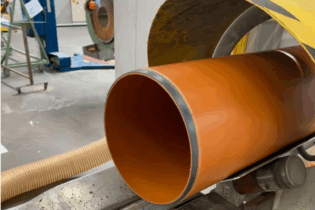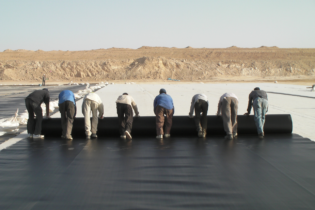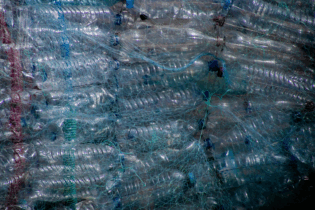When it became apparent that a new landfi ll was on the cards for Rustenburg, the Rustenburg Local Municipality looked to Golder Associates Africa on how to best facilitate this. Andre Venter, divisional leader: Integrated Waste Solutions and project manager for the development and construction supervision at the site, discussed some of the project’s challenges.
Venter says, ‘A disposal-needs assessment indicated that a landfill with airspace capacity of between 4.8 and 8.8 million m3 was required for a 30-year period. Nine potential candidate landfill sites in the Rustenburg area were identified and evaluated in terms of their economic, social, technical and environmental suitability. We decided on the Waterval site, which covers 107 ha, situated on land owned by Anglo Platinum and historically subject to underground and opencast mining. When mining activities were abandoned in the mid-nineties, the mine amended the EMPR to accommodate the new waste disposal facility.’ Golder was appointed as the consulting engineer for the licensing and design stage, as well as construction management and supervision of the project. The current contract includes site clearance and bulk earthworks, two general waste disposal cells including landfill liner systems and drainage systems, a lined inert rubble disposal cell, the construction of a leachate and contaminated stormwater ponds, site roads, water reticulation, and sewer and stormwater systems. In addition, the contract also includes the construction of various on-site buildings and facilities such as ablution and canteen New landfill rewrites history facilities, an educational/training centre, a guard house, taxi stop, weighbridges, workshop, public drop-off facility and fencing. Venter and his team identified that the abandoned opencast pits, after being equipped with appropriate liner systems, could be used as cells for the disposal of general and inert waste. Existing stockpiles and berms could also be used for construction or the daily cover material during the operational life of the landfill. During the end-of-life closure and rehabilitation of the operation, the site will be shaped and capped with a liner and covered with a layer of topsoil and vegetation. Says Venter, ‘The development of the site has been split into two phases with the majority of Phase 1 development taking place as part of the current construction contract. Phase 1 consists of a relatively small pit (25 000 m3) that will be developed into a rubble disposal cell. Four large general-waste cells (two of which are being constructed under the current contract) surround the pit. A significantly larger pit is located in the area set aside for Phase 2, which at a later stage could significantly increase the size of the facility. ‘The current contract will see the construction of disposal facilities allowing for mainly general waste (non-hazardous waste), as well as inert building rubble. It is anticipated that the site will receive between 137 000 and 210 000 tonnes of waste per annum. With the two general waste cells currently being constructed, this would equate to a capacity for between six and eight years, depending on growth and recycling efforts. Should the other two larger cells, which also form part of Phase 1 be constructed, the total capacity will increase to approximately 15 years.’ The landfill is classified, in terms of the Minimum Requirements, as a GLB- facility, i.e. general waste (G) disposed in a large landfill (L) that has little potential to generate leachate due to rainfall and evaporation (B-). It has been allocated a Class B certification in terms of the new National Environmental Management: Waste Act 2008 (Act nr 59 of 2008) GN R 636: National Norms and Standards for Disposal of Waste to Landfill. The facility will serve the district of Rustenburg and surrounding towns will be incorporated in the future. Although not part of the current construction contract, a materials recovery facility as well as composting facility is envisaged for the near future. Allowance has also been made in the design for landfill gas extraction and management, which is gaining in popularity and a requirement for landfills in South Africa. Functions of each major facilityThe two large waste cells will receive general, non-hazardous waste. These cells are equipped with a Class B liner and drainage systems. The liner system includes a layer of geosynthetic clay liner, which is covered by a 2 mm HDPE geomembrane. This is covered by a non-woven geotextile under a 150 mm stone layer with a woven geotextile covering. Perforated pipes are installed within the stone layer at given intervals to collect any leachate. The perforated pipes, which are within the lined cells, flow into a sealed leachate pipe that leads to the leachate pond. Water that runs off the top of the waste in the cells, which is considered less polluted, will flow out of the cell and into the contaminated stormwater pond through a spillway. When operations begin, the liner system will be carefully covered by a pioneering layer of waste for protection. After this, waste will be deposited into the cell and then covered with a soil layer on a daily basis. Waste will also be compacted to optimise the use of airspace and extend the life of the facility.
Rubble disposal cell
The construction of the rubble disposal cell is challenging and interesting from an engineering perspective. Constructed in an abandoned opencast mining pit, an earth stabilised wall had to be built in order to line the walls of the pit. The wall is constructed in geogrid reinforced layers with a liner being installed to cover the wall every five to seven layers. Wick drains and a sump system were constructed behind the wall to collect any water that may accumulate in this area, while another sump is to be constructed within the liner layers to collect leachate inside the cell. The cell will be used to dispose of building rubble and will have the same liner system as for the cells. A wide slope has been formed and compacted with an entrance ramp into the pit to allow for trucks to enter and exit.
Two ponds are currently under construction: the leachate and contaminated stormwater pond. The liner system on the ponds is essentially a triple liner system with two leakage detection layers. The compacted surface is covered by a 1.5 mm HDPE geomembrane, which is then covered by a cuspated drainage layer. This layer acts as the secondary leakage detection layer and any water that enters the layer will be diverted to a sump where the water will be detected. A second, 1.5 mm HDPE liner is then installed and covered by another cuspated drainage layer, the primary leakage detection layer, also connected to a separate sump. Any significant amount of water found in either leakage detection layer would indicate a leak in the system that would require attention. These two liners and drainage layers are then covered by a 2 mm HDPE geomembrane. During collection, the highly polluted leachate, which has run through the waste in the cells, will be diverted to the leachate pond, while the less polluted, but still contaminated, run-off will flow to the contaminated stormwater pond. Contaminated runoff is water which has either flowed over the surface of the waste or water which may be contaminated by activities on-site. The runoff in the contaminated stormwater pond will be subjected to evaporation or used for dust suppression; however, the water will only be used to suppress dust in the ‘contaminated areas’. The highly polluted leachate, which is channelled to the leachate pond, will be evaporated or may be removed for treatment at the nearby Rustenburg sewage treatment plant if necessary. Perimeter berms surrounding the entire site will separate clean and dirty run-off. Thus, all run-off from the areas outside the perimeter berms will be clean and may safely drain into the surrounding environment. Public drop-off facility
This will be constructed on the infrastructure platform. It is a raised area with a ramp for private users to drive up, park and off-load waste into skips located on a lower level. Facilities for recycling will also be installed. Materials recovery facility
Feasibility studies will determine its construction. It will allow for materials to be separated making sure that only non-recyclables are sent to the cells. This will not only increase lifespan, but also create additional jobs. Challenges
The project is not without its challenges however, states Venter. ‘It is a quarry site, so the engineering designs and liner requirements are very conservative to ensure all environmental risks are properly managed – specifically the groundwater. Ongoing underground mining activities result in water still being pumped out, with the water table in places as deep as 1 500 m under the ground. Studies have also shown that even if the mining stopped, the water table could need 80 years to rise to pre-mining conditions, so chances the landfill will impact it would be highly unlikely.’ For Golder, it has been a unique project in terms of its engineering and environmental challenges, water management, public participation and other additional studies that were required. The size of the site, coupled to the fact that its design takes into consideration aesthetics as well as environmental initiatives, means that it will blend very well into the existing environment. Policing, monitoring and management of the site are crucial to ensure the facility complies with the conditions of the waste-management licence. The creation of short-term employment opportunities, with an approximate R15 million financial investment in the local eco nomy of the area, is a great bonus to the community and the industry at large.








